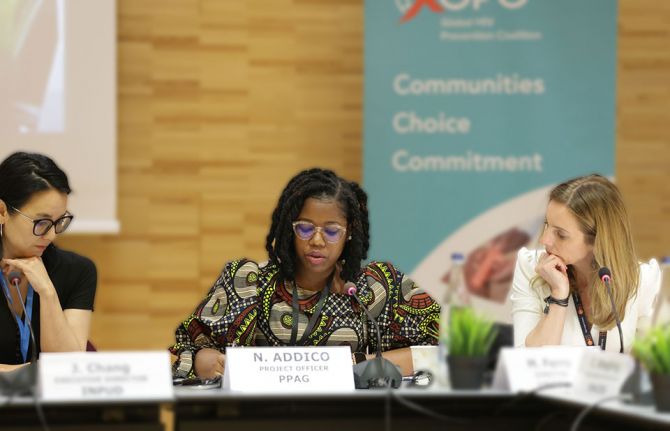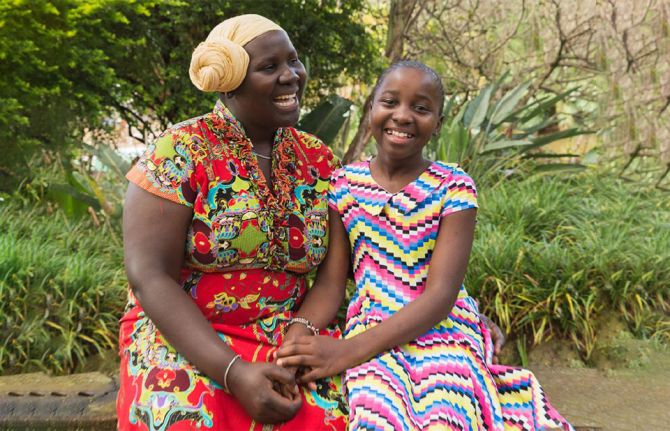
Feature Story
Uniting against female genital mutilation
04 марта 2008
04 марта 2008 04 марта 2008
The Interagency Statement on
Eliminating Female genital
mutilation was signed by
UNAIDS, UNDP, UN Economic
Commission for Africa, UNESCO,
UNFPA, the Office of the High
Commissioner on Human Rights,
UNHCR, UNICEF, UNIFEM and
WHO.
Reaffirming their commitment to the elimination of female genital mutilation, 10 United Nations bodies including UNAIDS, have expressed their commitment to support governments, communities, and women and girls to abandon the practice within a generation.
There are a growing number of examples in countries around the world where the prevalence of female genital mutilation has declined. The interagency statement “Eliminating female genital mutilation” is a joint initiative to support the scaling up of good examples to become common practice.
Female genital mutilation, also called female genital cutting and female genital mutilation/cutting, violates the rights of women and girls to health, protection and even life as the procedure sometimes results in death. Although decades of work by local communities, government, and national and international organizations have contributed to reducing the prevalence of female genital mutilation in many areas, the practice remains widespread.
Damages public health and human rights
Between 100 and 140 million women and girls in the world are estimated to have undergone female genital mutilation and 3 million girls are estimated to be at risk of undergoing the procedures every year.
The statement points out that female genital mutilation is a manifestation of unequal relations between women and men with roots in deeply entrenched social, economic and political conventions.
The practice is believed to enhance a girl’s chastity and chances of marriage by controlling her sexuality. As such, it not only infringes on women’s sexual and reproductive health; it also perpetuates gender roles detrimental to women.
"We recognize that traditions are often stronger than law, and legal action by itself is not enough,” said all the agencies involved. “Change must also come from within. This is why it is critical for us to join hands and work closely with communities and their leaders so that they can bring about sustainable social change.”
Health complications of female genital mutilation
The statement highlights the damaging effect of female genital mutilation on the health of women, girls and newborn babies. Immediate risks of the practice include severe pain, shock and even death through hemorrhaging. The use of the same surgical instrument without sterilization could increase the risk for transmission of HIV between girls who undergo female genital mutilation together.
Long-term health risks include chronic pain, reproductive tract infections, birth complications and psychological consequences. An increased risk for bleeding during intercourse may increase the risk for HIV transmission. The increased prevalence of herpes in women subjected to female genital mutilation may also increase the risk for HIV infection, as genital herpes is a risk factor in the transmission of HIV.
The UN said, “We are becoming increasingly concerned about the medicalisation of female genital mutilation. This is where the mutilation is performed by health professionals in health facilities. The argument that a mild form performed by medically trained personnel is safer is commonly heard in countries where female genital mutilation is practiced. But this should never be considered as an option."
The statement argues that the treatment and care of the adverse health consequences of female genital mutilation should be an integral part of health services, such as safe motherhood and child survival programmes, sexual health counselling, psycho-social counselling, prevention and treatment of reproductive tract infections and sexually transmitted infections including HIV and AIDS, prevention and management of gender-based violence, youth health programmes and programmes targeting traditional birth attendants (who may also be traditional circumcisers).
New evidence and lessons learned
The interagency statement is based on new evidence and lessons learnt over the past decade. It highlights the wide recognition of the human rights and legal dimensions of the problem and provides current data on the prevalence of female genital mutilation.
It summarizes findings from research on the reasons why the practice continues, highlighting that the practice is a social convention which can only be changed through coordinated collective action by practising communities. It also summarizes recent research on its damaging effects on the health of women, girls and newborn babies.
Drawing on experience from interventions in many countries, the new statement describes the elements needed, for both working towards complete abandonment of female genital mutilation, and caring for those who have suffered, and continue to suffer, from its consequences.
The Interagency Statement on Eliminating Female genital mutilation was signed by the Joint UN Programme on HIV/AIDS (UNAIDS), the UN Development Programme (UNDP), The UN Economic Commission for Africa (UNECA), the UN Educational, Scientific and Cultural Organizations (UNESCO), the UN Population Fund (UNFPA), the Office of the High Commissioner on Human Rights (UNHCHR), The UN Refugee Agency (UNHCR), UNICEF, the UN Development Fund for Women (UNIFEM) and the World Health Organization (WHO).
Uniting against female genital mutilation
Cosponsors and partners:
UN Development Programme (UNDP)
UN Economic Commission for Africa (UNECA)
UN Educational, Scientific and Cultural Organizations (UNESCO)
UN Population Fund (UNFPA)
The Office of the High Commissioner on Human Rights (UNHCHR)
UN Refugee Agency (UNHCR)
United Nations Children Fund (UNICEF)
UN Development Fund for Women (UNIFEM)
World Health Organization (WHO)
External links:
WHO Department of Reproductive Health and Research
Publications:
Eliminating Female genital mutilation. An interagency statement. (February 2008)
Related
 Young role models combat HIV stigma in Central Asia
Young role models combat HIV stigma in Central Asia

22 июня 2023 года.
 The urgency of HIV prevention among adolescent girls and young women
The urgency of HIV prevention among adolescent girls and young women

01 июня 2023 года.
 United for ending cervical cancer, HIV and inequities for women and girls
United for ending cervical cancer, HIV and inequities for women and girls

17 ноября 2022 года.
